Walk-In Closet Dimensions For Maximizing Your Space
Walk-in closets are an incredibly useful design feature and a great way to add luxury to a bedroom. They offer plenty of storage space to move around, and some even feature central islands for organization, seating, or a table to pack your luggage. With this many factors present, it only makes sense that the dimensions that work for one homeowner might not fit another homeowner’s needs. That’s why we’ve broken down all the major factors you need to consider to decide the appropriate size.
What Is the Standard Size of a Walk In Closet?

While there is no standard size, the minimum size to be considered is 4ft by 4ft.
This layout will provide enough space to accommodate shelving and hanging clothing on the back wall and one side wall. It also maintains enough room for closet doors to open without impediment.
Click this link to read more about standard closet height measurements.
What is a Good Size for a Primary Closet?

Master bedrooms are the biggest bedroom in a home and often feature additional amenities such as large closets or attached bathrooms. As such, the standard dimensions for master walk-in spaces are larger than those located in a standard-sized room.
At a minimum, a master walk-in closet design should be 7’ x 10’ or 70 sq. ft, with preferably at least 100 sq. ft. of total space.
This gives you ample room to add shelves, rods, shoe storage, and even cubbies to hold two people’s clothes. In addition, it will also give you enough space to move around and organize your belongings without feeling cramped or too closed in.
Small Walk-In Closet Sizes
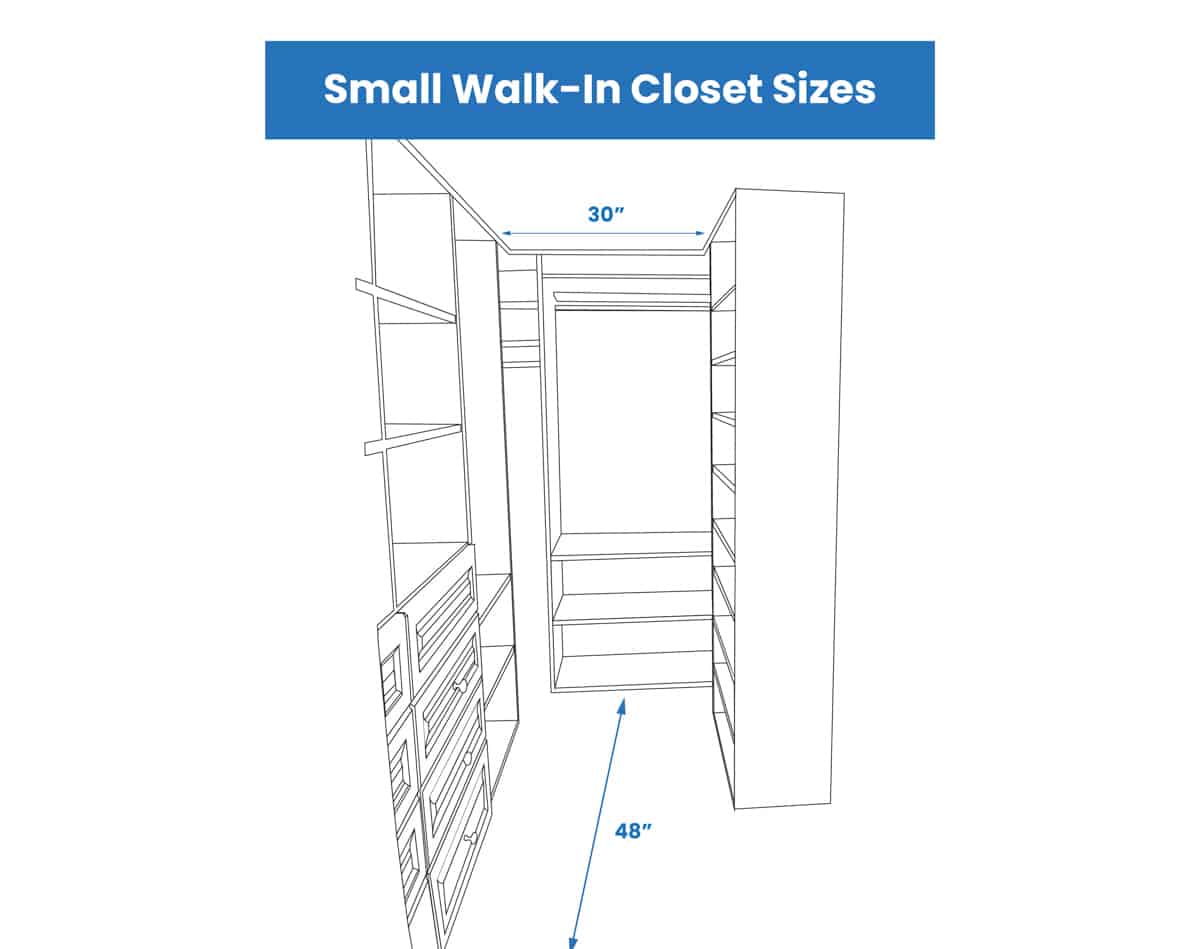
Of course, if you can’t have or don’t want a full-size walk-in space, it doesn’t mean that you can’t have one at all. Instead, you can opt for a smaller floor plan that will still do the trick to give you some extra space compared to a standard reach-in type.
The smallest recommended dimensions are a width and depth of 4 feet each. To meet the requirements of the Americans with Disabilities Act, you’ll need to use the minimum dimensions of 30 inches wide and 48 inches deep for the walkway. If you or anyone in your family is older and has a disability affecting mobility, these ADA standards are important to consider.
Narrow Walk-in Measurements
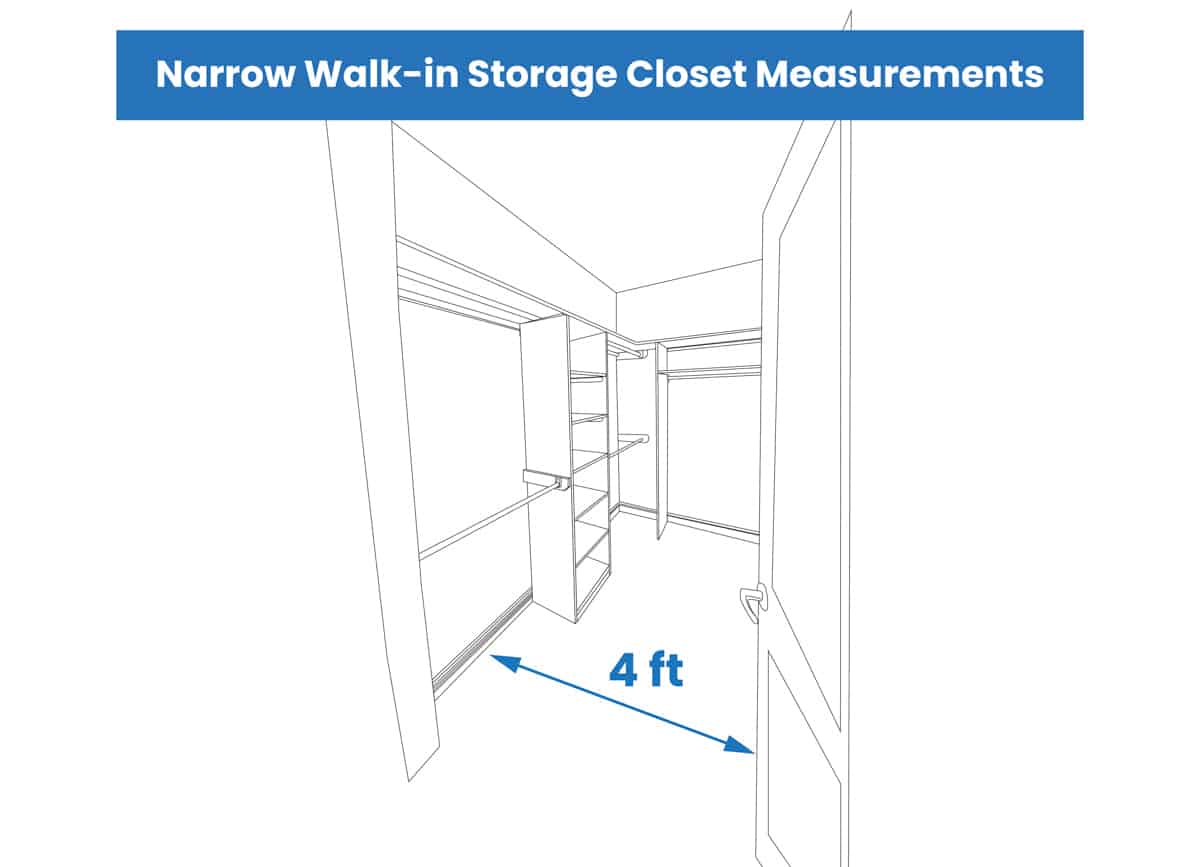
If you’re designing a narrow walk-in closet, you won’t want to change the width to measure less than the 4’ minimum. Again, if you or anyone using the space has a disability affecting their mobility, it’s best to keep the ADA standards in mind. From here, you can decide on the other dimensions of your layout.
Well-designed walk-in closets are important aspects of any master suite. They are often set with an easy access to bedroom. – Space Planning: Comprehensive Guide for Residential Interior Space Planning, Lamie E
Narrow types are often longer than they are wide as well. So, the length is likely larger than the width if you’re trying to design a narrow organization space.
How Wide Does A Closet Need To Be For An Island?
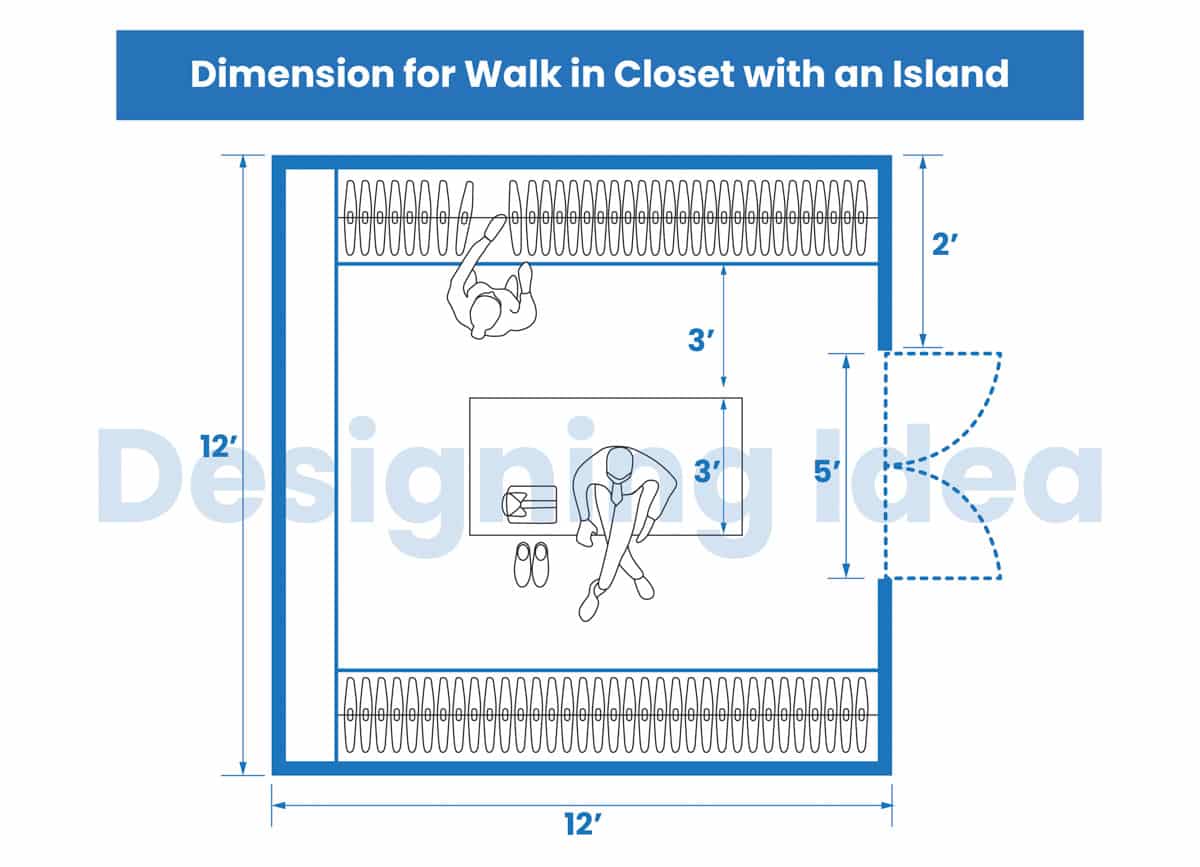
Having an island in your walk-in closet has a lot of benefits. It can be used as a place to fold clothes, pack luggage, and many islands even feature extra storage space. However, if a storage room isn’t sized correctly, islands can end up adding clutter rather than functionality.
Ideally, an island will have a minimum walkway width of 36 inches on every side. This allows you room to get around it and ensures it won’t push directly up against any storage situated against the walls. To accommodate this, as well as space for shelves and clothes, you will need to have dimensions measuring at least 12’ x 12’.
How Deep Should Closet Shelves Be?

The measurements for the depth of reach-in shelves and walk-in shelves use a similar formula. You don’t want the shelf to be so high that you can’t reach it without aid or so deep that items on the back of the shelf are hard to reach. However, you also don’t want the shelves to be so low that they don’t press directly against rods or are too shallow to store items properly.
The recommended shelf depth for reach-in types usually depends on the depth of the space itself. However, for walk-in types, where there isn’t as much limitation, the standard is 16”, although it isn’t uncommon for smaller walk-in closets to use 12” deep shelves that jut out in equal depth to the distance of the rod from the wall.
How Wide Does a Closet Need to Be to Walk Inside?
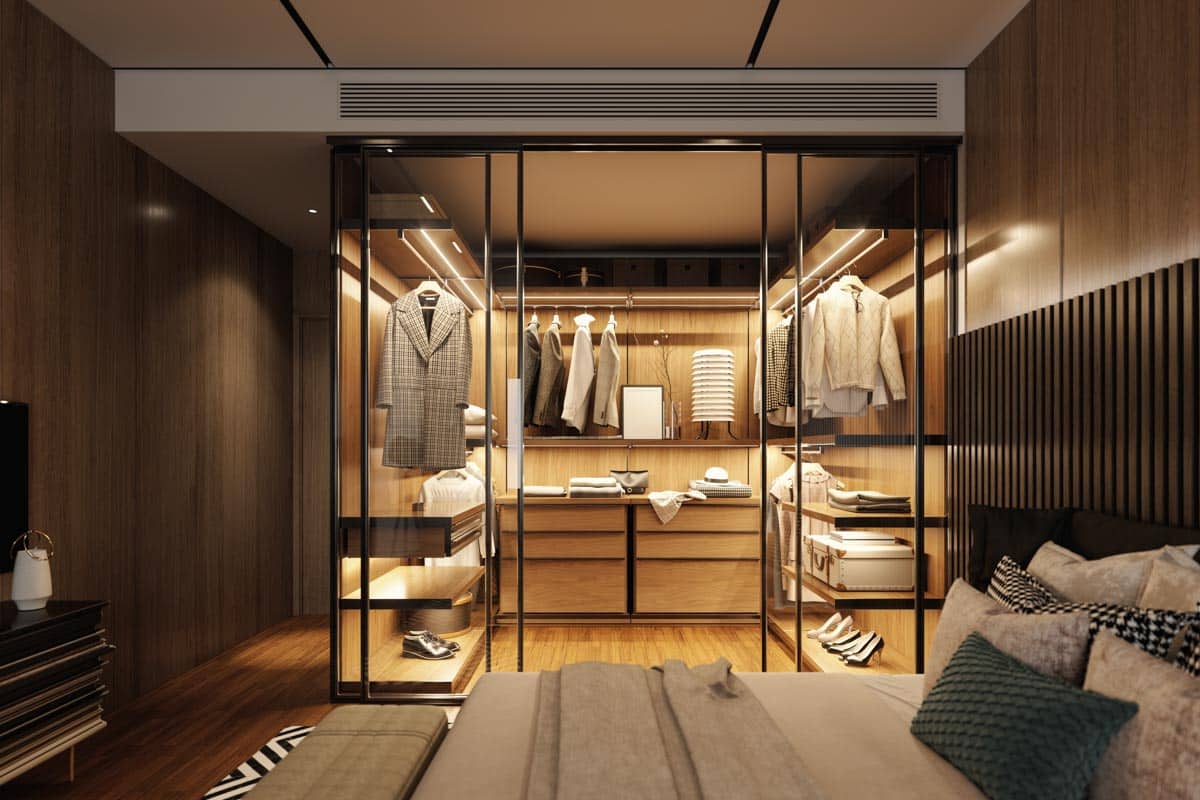
How broad the walk-in closet should be hinges on your personal preferences or storage requirements, room layout, and available space. For example, small homes cannot allocate space exceeding 4 feet or 1.2 meters without sacrificing other building elements or structures. Ideally, you’ll want to check how much room you have to determine a walk-in closet’s width. As far as the maximum width goes, residential storage spaces have no limits except for a minimum of 4 feet.
This measurement complies with the Americans with Disabilities Act, requiring establishments to provide accessible amenities to people with disabilities. The 4-foot-wide walk-in closet should be enough to accommodate such individuals, even those in wheelchairs. However, architects and interior designers recommend ditching the closet doors for easier access to clothing, bags, shoes, and other items. Adding a closing mechanism on a shelf can only make the storage look more cramped.
Ideally, you’ll want the space larger than 4 feet. Hence, many homeowners consult interior designers and home layout planners to define their walk-in closets relative to available space. They must also consider other parameters or factors in designing the smallest closet without undermining function, aesthetics, and accessibility.
If you’re adding a walk-in closet in the master bedroom, 4 feet won’t be enough. Your absolute minimum should be 7 feet or a little over 2 meters. This measurement is sufficient for two cabinets facing each other on opposite sides of the wall, allowing you to move freely and organize as many items as you need. Shoe storage, shelves, and cubicles should have no issues fitting into this space.
On the other hand, walk-in closets with an island set the minimum width at 12 feet or 3.7 meters. Again, these measurements are relative because you must consider the island’s width. The setup requires at least 3 feet of walking space around the island. If you have a 3-foot wide island, you’ll need 9 feet (2.7 meters) of clearance between the two opposing closets’ outer (or front) edges.
As mentioned, your home’s layout limits the walk-in closet’s maximum width. Hence, you can build a chamber as large as a low-cost housing unit. Although some homeowners might consider such installations wasteful, it remains your prerogative.
Minimum Dimensions For a Closet

Walk-in closets are excellent storage solutions for modern households, allowing them to organize their stuff and prevent unnecessary incidents. Although we know these spaces’ minimum widths (4 feet for the standard room, 7 feet for the master, and 12 feet for an island-integrated closet), you might want to learn how many feet (of length) you can escape with without sacrificing a closet’s functionality and freedom of movement.
So, a standard room (or even homes with cramped spaces) can benefit from a squarish 4 feet by 4 feet walk-in storage chamber. These measurements are sufficient to move around, given most cabinets are about 16 inches deep or about 41 centimeters. Unfortunately, you can only have one cabinet on one side of the wall because the remaining space will only be 32 inches or a little over 2.5 feet. You could opt for a “shallower” 12-inch-deep shelving to increase the closet space to 3 feet.
Meanwhile, a master walk-in closet can benefit from a rectangular layout, with its front-to-rear section 3 feet longer than the width (at 7 feet). Ten feet (about 3 meters) should be sufficient for couples, allowing them to store their belongings (i.e., shoes, wardrobe, books, bags, and other items). Homes with large types of rooms can get away with a 12-foot by 12-foot (about 3.66 meters by 3.66 meters) walk-in closet with an island. Of course, you can opt for something more substantial, especially if your house has space to spare. These dimensions are the lower limits of what you can build.
Please allocate about 3 feet of walkway on all sides of the island to avoid bumping into the furnishings or the opposing cabinets. Hence, it’s also wise to consider the closet shelving’s depth. Pegging this factor at 12 inches should give you an island not larger than 4 feet across. If you shrink the island to 3 feet, you can extend the cabinet’s depth to around 16 inches.
Large Dimensions For a Roomy Closet
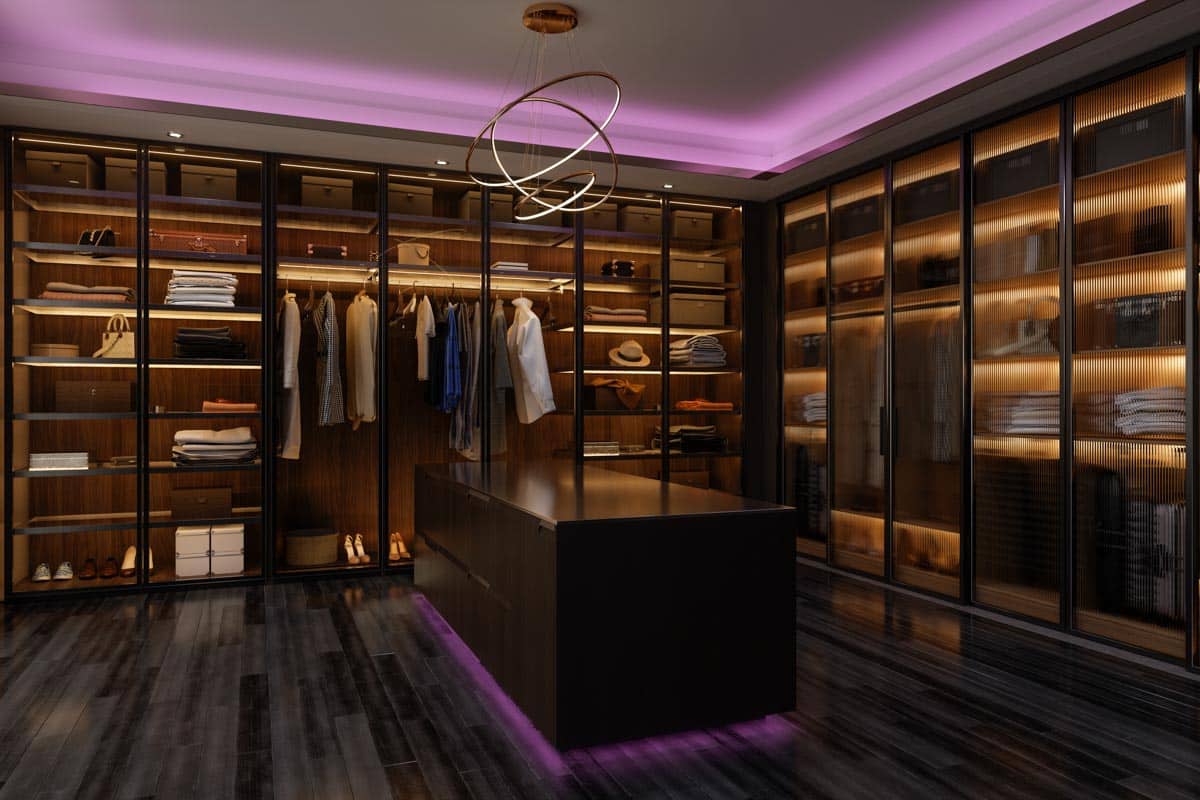
We know a walk-in closet should be at least 16 square feet or about 1.5 square meters, while a master unit is at least 70 square feet (about 6.5 square meters). Larger homes can opt for a 200- to 264-square-foot closets (roughly 18.5 to 24.5 square meters). These sections can measure 10 to 12 feet side-to-side (3 to 3.6 meters), mimicking a small retail shop. They can also span 20 to 22 feet front-to-back (6 to 6.7 meters), giving the layout a sense of luxury. Some families might outdo these dimensions, allowing them to customize elements and add creative touches to their storage space.
Although even if space isn’t an issue, you must plan the large walk-in closet’s layout. You can create “zones” within the room to keep things organized. Ideally, you’ll want to maximize every square inch, including vertical spaces. Adding corner and wall shelving can improve the closet’s functionality.
If you dream about a “luxury” walk-in closet, you can aim for a slightly smaller room and compensate by adding the most lavish elements money can buy. Most families with this set up do well with space spanning 8 to 10 feet side to side and 12 to 16 feet front-to-back. Of course, a closet island in the center requires a larger space, especially if you want a multi-purpose island.
His and Hers Closet Measurements

Standard walk-in closet measurements don’t exist for men and women because everything depends on how many clothes you have and your home’s available space. You can also consider the room’s layout, whether it allows a conventional 4×4 or some other size.
In general, women have a more extensive collection of clothes than men. Recent market surveys reveal that American women, on average, have about 132 clothes, bags, shoes, and other items in their closets. On the other hand, men only have about 43, for a whopping 1:3 ratio.
Unsurprisingly, most of his and her walk-in closets allocate a third of the storage space for the husband or male partner, while the wife or female partner gets a larger share (2/3).
Most households with a his and hers floor plan arrangements measure 7 feet across (about 2.1 meters) and 10 feet deep (roughly 3 meters), underscoring its semblance to a unit in the master bedroom.
However, some couples prefer a slightly bigger storage capacity, measuring 100 square feet (about 9.3 square meters). It could be a 10 feet by 10 feet (3-meter) layout or an 8 feet (2.4 meters) by 12.5 feet (3.8 meters) format.
These dimensions are substantial for a couple. However, you must also consider available space. For instance, you might dream of a 100-square-foot walk-in, but the room only has 80 square feet available.
How to Make a Small Closet More Functional
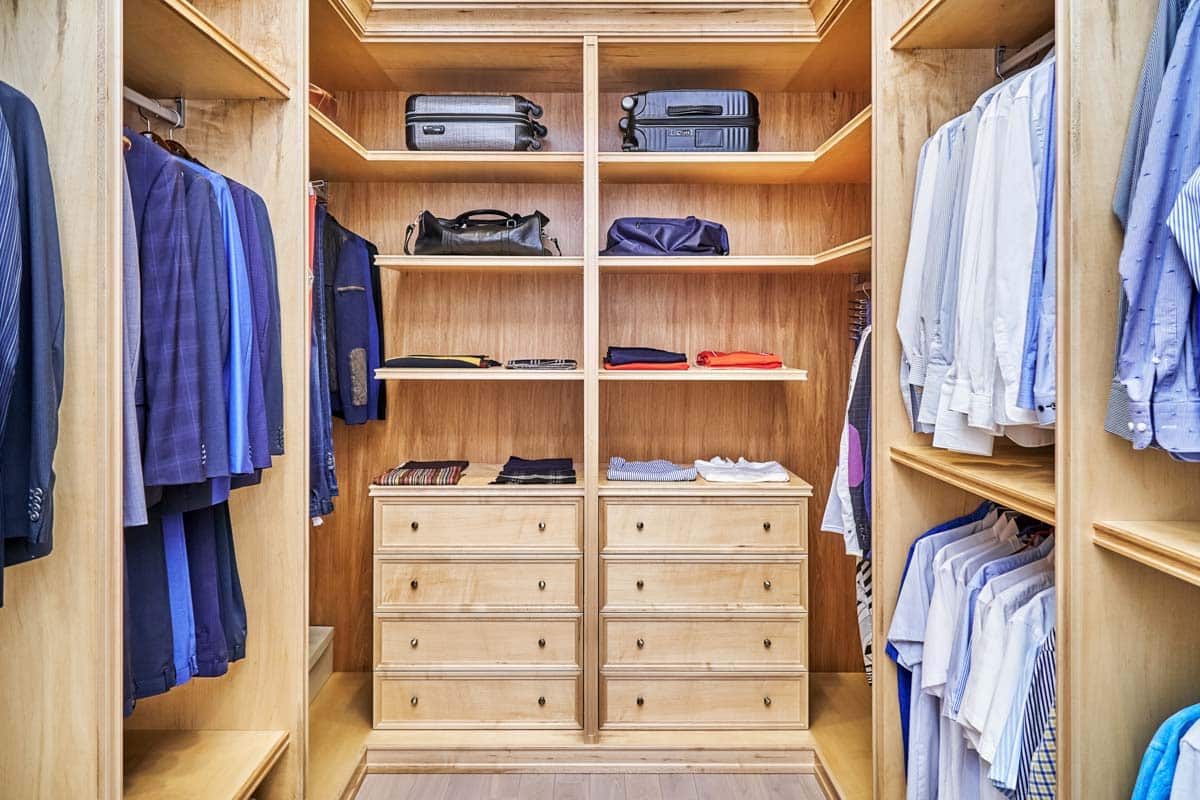
Not everyone has spacious homes, inhibiting them from organizing and storing every valuable and belongings they have. However, just because your walk-in closet is a cramped 4×4 doesn’t mean you are helpless. You can still make this chamber functional by adhering to the following ideas.
• Ditch the door: Most closet door sizes, although thin, can still occupy space. Sometimes, they can also brush against clothes hanging on a rod inside the opening (especially for “extra-wide” and “hefty” clothing).
You can opt for a doorless walk-in design to give the room a “livable” vibe. However, note that you must be more meticulous in organizing and storing your stuff to avoid turning the design into an eyesore.
• Turn the walk-in into a multifunctional space: Plan the doorless floor plan to include a wardrobe cabinet on one side, occupying only a quarter to a third.
Transform the remaining three-quarters or two-thirds into a dressing room with tables, chairs, a full-length mirror, and a small storage cabinet on one side. And if you have extra space, you can turn it into a nook for your pet. Unfortunately, a 4×4 might be unsuitable for such an approach.
• Leverage modern storage solutions: The issue with conventional closet rods is that you don’t maximize the space underneath the hung clothes. Thankfully, many large retailers (i.e., Walmart) offer portable storage solutions, like plastic bins, baskets, and open cubbies.
You can throw shoes, bags, and other items into these things. The good thing about these products is you can nest them when empty, freeing space for other stuff in the area.
• Go vertical: Optimizing storage space requires utilizing every square inch. In most cases, the cabinet’s upper section will be empty. You can store boxes of stuff in this area, preferably items you rarely use. Otherwise, these objects are better off in the cabinet’s main storage section.
• Add shelving and / or drawers: If there’s extra space on the side, you can build a multi-story shelving to accommodate undergarments, folded clothing, jewelry boxes, and other objects. Alternatively, you can add drawers for privacy. Some homeowners prefer transparent or translucent cubbies to give them an idea of the contents.

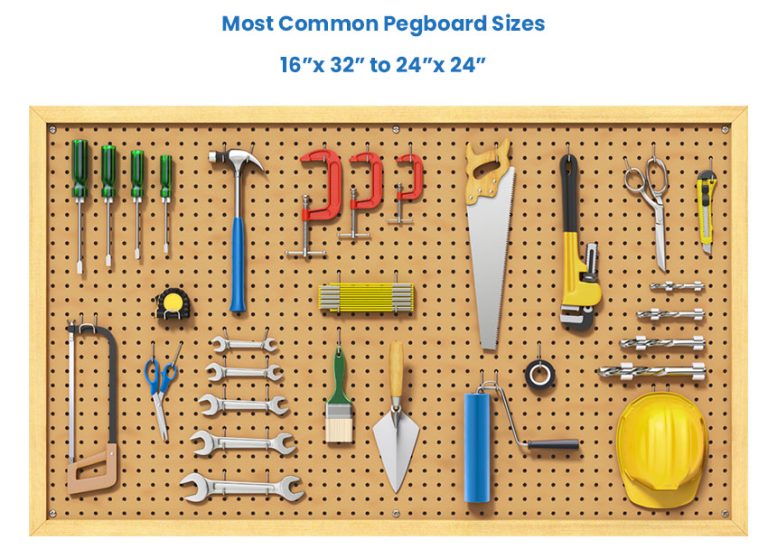
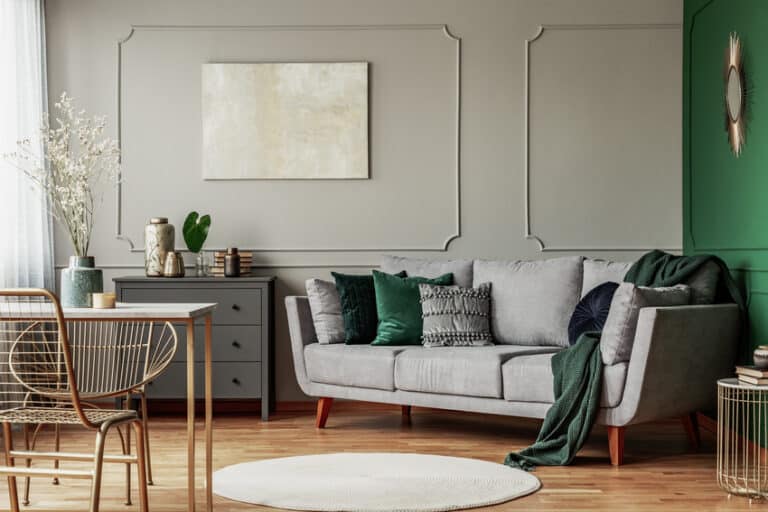
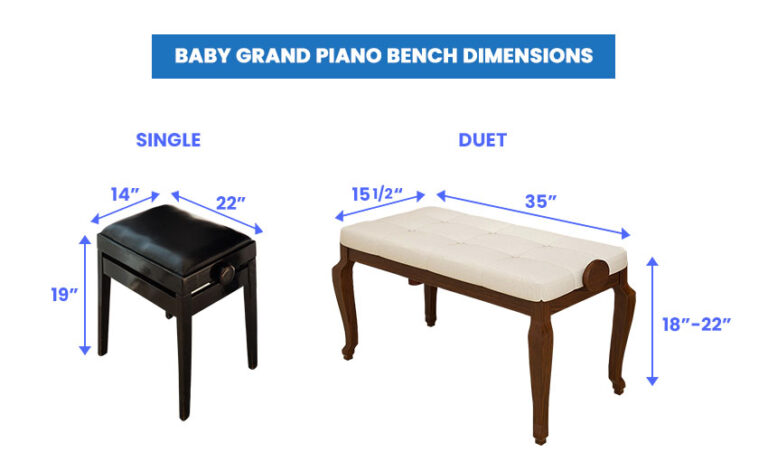
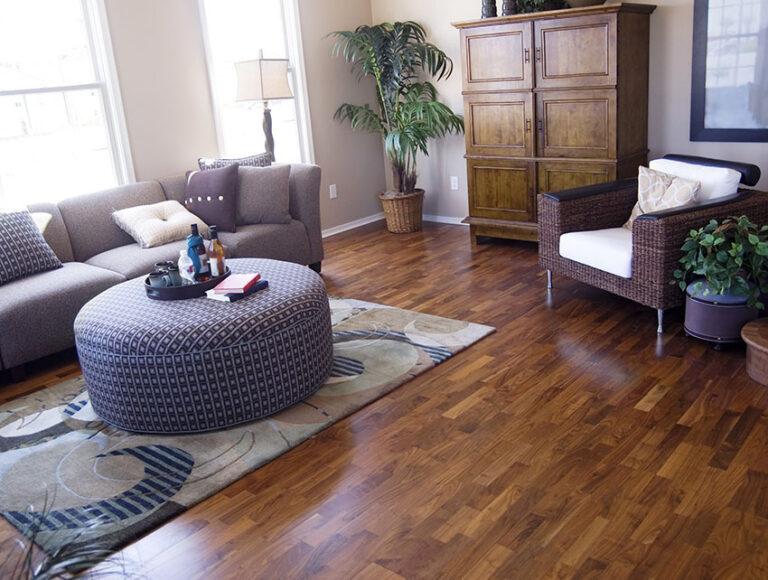

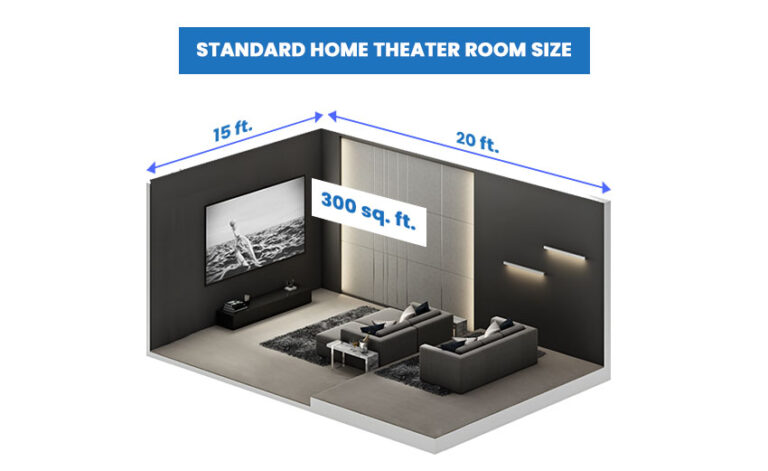
“At a minimum, a master walk-in closet design should be 7’ x 10’ with at least 100 sq. ft. of total space in the closet. ”
This sentence seems to contradict itself.
7×10=70sf yet the same sentence ends with requiring at least 100sf
Hi, thank you for your comment. I’ve added to the sentence to make it a little clearer to understand.
Do you have an example of a 7 x 10’ closet design?